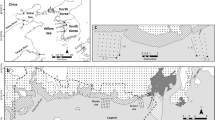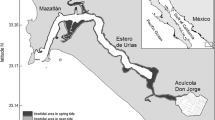Abstract
We experimentally evaluate the effect of migratory shorebirds on the benthic fauna of three southwestern Atlantic Argentinean stop-over and wintering sites: Bahía Samborombon (35°30′–36°22′S, 57°23′W), Mar Chiquita coastal lagoon (37°40′S, 57°26′W), and Bahía Blanca (38°48′–39°25′S, 50°–62°25′W). The experiments consisted of exclusion ceilings and controls (both 1 m2), with 10 replicates each and aligned at the same tidal level. During December 1994–May 1995 these experiments were done, twice in Bahía Samborombon, twice at two sites (Sotelo and Celpa) 4 km apart in Mar Chiquita coastal lagoon, and three times in Bahía Blanca. Three polychaete species (Laeonereis acuta, Nephtys fluviatilis, andHeteromastus similis) were found in similar densities in both areas of the Mar Chiquita lagoon.L. acuta andN. fluviatilis were affected in Sotelo, but there was no treatment effect in Celpa. In Sotelo the most abundant shorebirds were Hudsonian godwit (Limosa haemastica), American golden plover (Pluvialis dominica), and White-rumped sandpiper (Calidris fuscicollis), and in Celpa the most abundant shorebirds were White-rumped sandpiper, two-banded plower (Charadrius falklandicus), and lesser yellowlegs (Tringa flavipes). The largest polychaete densities were in the upper sediment layer (0–6 cm), which was also the most affected layer. Three polychaete species were found in Bahía Samborombon (L. acuta, H. similis, andNeanthes succinea), but onlyH. similis showed a treatment effect. The most abundant shorebirds in Samborombon were white-rumped sandpiper and two-banded plover. No effect was detected in Bahía Blanca, where the most abundant shorebirds were white-rumped sandpiper and American golden plover. In all cases, the species affected by shorebirds were the most abundant species. From the two sites of Mar Chiquita, there was a treatment effect only in Sotelo, which was also the area with higher shorebirds counts. However, much lower densities observed in Samborombon (similar to the unaffected area of Mar Chiquita) also produced a significant decrease in infaunal abundance. These evidences also suggest that just selection of study sites may produce different views of the interaction between shorebirds and benthic species.
Similar content being viewed by others
Literature Cited
Blanco, D. E., P. González, andM. M., Maritinez. 1995. Migración de la becasa de marLimosa haemastica (Aves, Scolopacidae) en el sur de América del Sur.Vida Silvestre Neotropical 4:119–124.
Botton, M. L. 1984. Effects of laughing gull and shorebird predation on the intertidial fauna. at Cape May New Jersey.Estuarine, Coastal and Shelf Science 18:209–220.
Bryant, D. M. 1979. Effects of prey density and site character on estuary usage by overwintering waders (Charadrii).Estuarine, Coatstal and marine Science 9:369–384.
Conover, W. J. 1980. Practical Nonparametric Statistics. Second edition. John Wiley and Sons, Inc., New York.
Dabbene, L. 1920. Notas sobre los chorlos de Norteamérica que invernan en la Repulica Argentina.Hornero 2:99–128.
Fairweather, P. G.. 1991. Statical power and design requirements for environmental monitoring.Australian Journal of Marine and Freshwater Research 42:555–557.
Goss Custard, J. D. 1984 Intake rates and food supply in migrating and wintering shorebirds.In J. Burger and B. L. Olla (eds.), Shorebirds: Migration and Foraging Behavior 6:233–277.
Goss Custard, J. D. 1985. Foraging behavior of wading birds on the carrying capacity of estuaries.In R. M. Sibly and R. H. Smith (eds.) Behavioural Ecology. Blackwell Scientific Publications, Oxford. England
Mercier, F. andR. McNeil. 1994. Seasonal variation in intertidal density of invertebrates prey in a tropical lagoon and effects of shorebird predation.Canadian Journal of Zoology 72:1755–1763.
Morrison, R. I. G. and B. A. Harrington. 1979. Critical shorebird Resources in James Bay and eastern North America. Transactions of the 44th American Wildlife and Natural Resources Conference, Wildilife management Institute, Washington D.C.
Morrison, R. I. G. andJ. P. Myers. 1987. Wader migration systems in the New World.Wader Study Group Bulletin 49:suppl/IWRB Special Publication, 7:57–69.
Morrison, R. I. G. andR. K. Ross. 1989. Atlas of Neartic shorebirds on the coast of South America.Canadian, Wildlife Service Special Publication 2:131–323.
Mouritsen, K. N. andK. T. Jensen. 1992. Choice of microhabitat in tactile foraging dunlinsCalidris alpina: The importance of sediment pentrability.Marine Ecology Progress Series 85:1–8.
Myers, J. P., R. I. G. Morrison, P. Z. Antas, B. A. Herrington, T. E. Jovejoy, M. Sallaberry, S. E. Senner, andA. Tarak. 1987. Conservation strategy for migratory species.American Scientist 75:19–26.
Myers, J. P. andL. P. Myers. 1979. Shorebirds of coastal Buenos Aires Province, Argentina.Ibis, 121:186–200.
Myers, J. P., S. L. Williams, andF. A. Pitelka. 1980. An experimental analysis of prey availability of sanderlings (Aves: Scolopacidae) feeding on sandy beach crustacean.Canadian Journal of Zoology 58:1564–1574.
Olrog, C. 1967. Observaciones sobre aves migratorias, del hemisferio norte.Hernero 10:292–298.
Pienkowski, M. W. 1981. How foraging plovers cope with environmental effectal effects on invertebrate behaviour and availability.In N. V. Jones and W. J. Wolff (eds.), Feeding and Survival Strategies of Estuarine Organisms. Plenum Press, New York.
Piersma, T., 1996a. Family Charadriidae (Plovers),In J. del Hoyo, A. Elliot, and J. Sargatal (eds.) 1996. Handbook of the Birds of the World, Vol. 3. Hoatzin to Auks. Lynx Edicions, Barcelona, Spain.
Piersma, T. 1996b. Familiy, Scolopacidae (Sandpipers, Snips and Phalaropes), p.In J. del Hoyo, A. Elliot, and J. Sargatal (eds.), 1996. Handbook of the Birds of the World. Vol. 3. Hoatzin to Auks. Lynx Edicions, Barcelona, Spain.
Quammen, M. L. 1981. Use of exclosures in studies of predation by shorebirds on intertidal mudflats.Auk 82:812–817.
Quammen, M. L. 1984. Predation by shorebirds, fish, and crabs on invertebrates on intertidial mudflats: An experimental test.Ecology 65:529–537.
Schneider, D. 1978. Equalization of prey numbers by migratory shorebirds.Nature 271:353–354.
Velasquez, C. R. 1987. Depredación por parte de las aves sobre la macroinfauna intermareal de fondos blandos en el estuario del río Quelque (IX Región, Chile). Tesis Magister Ciencias Zoologicas, Universidad Austral de Chile Chile
Vila, A. R., E. R. Bremer, andM. Beade. 1994. Censos de chorlos y playeros migratorios en la Bahía Samborombón, Provincia de Buenos Aires, Argentina. Final report, Fundación Vida Silvestre Argentina. Buenos Aires, Agrentina.
Wanink, J. H. andL. Zwarts. 1993. Environmental effects on the growth rate of intertidal invertebrates and some implications for foraging waders.Netherland Journal of Sea Research 31:407–418.
Wilson, W. H 1990. Competition and predation in marine soft sediment communities.Annual Review of Ecology and Systematics 21:221–241.
Wilson, W. H. 1991. The foraging ecology of migratory shorebirds in marine, soft-sediment communities: The effects of episodic predation on prey populations.American Zoologist 31: 840–848.
Zar, J. H. 1984. Biostatical Analysis. Prentice-Hall, Inc., Englewood Cliffs, New Jersey.
Zwarts, L., A. M. Blomert andJ. H. Wanink, 1992. Annual and seasonal variation in the food supply harvestable by knotCalidris canutus staging in the Wadden Sea in late summer.Marine Ecology Progress Series 83:129–139.
Zwarts, L. andP. Esselink. 1989. Versatility of male curlews,Numerinus arquata, preying uponNereis diversicolor. Deploying contrasting capture modes dependent on prey availabity.Marine Ecology Progress Series 56:255–269.
Zwarts, L. andJ. H. Wanink. 1991. The macrobenthos fraction accesible to waders may represent marginal prey.Oecologia 87: 581–587.
Author information
Authors and Affiliations
Corresponding author
Rights and permissions
About this article
Cite this article
Botto, F., Iribarne, O.O., Martínez, M.M. et al. The effect of migratory shorebirds on the benthic species of three southwestern Atlantic Argentinean estuaries. Estuaries 21, 700–709 (1998). https://doi.org/10.2307/1353274
Received:
Accepted:
Issue Date:
DOI: https://doi.org/10.2307/1353274




